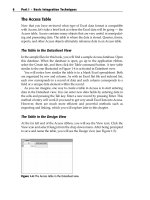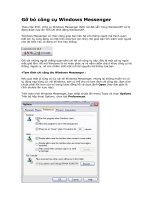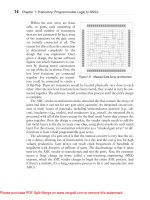Go with office 2013 1e a01 ppt
Bạn đang xem bản rút gọn của tài liệu. Xem và tải ngay bản đầy đủ của tài liệu tại đây (1.23 MB, 25 trang )
GO! with Office 2013 Volume 1
By: Shelley Gaskin, Alicia
Vargas, and Carolyn
McLellan
Access Chapter 1
Introduction to
Microsoft Access 2013
Objectives
• Identify Good Database Design
• Create a Table and Define Fields
in a Blank Desktop Database
• Change the Structure of Tables
and Add a Second Table
• Create a Query, Form, and Report
• Close a Database and Exit Access
Copyright © 2014 Pearson Education, Inc. Publishing as Prentice Hall.
2
Objectives (cont.)
• Use a Template to Create a
Database
• Organize Objects in the
Navigation Pane
• Create a New Table in a Database
Created with a Template
• Print a Report and a Table
Copyright © 2014 Pearson Education, Inc. Publishing as Prentice Hall.
3
Identify Good Database Design
• Database—an organized collection of
data
• Data—facts related to a specific topic or
purpose
• Information—data that is organized and
useful
• Flat database—simple database file not
linked to any other collection of data
• Relational database—database that
has multiple collections of related data
Copyright © 2014 Pearson Education, Inc. Publishing as Prentice Hall.
4
Identify Good Database Design (cont.)
• Tables—foundation of database
where data is organized into
rows and columns
• Record—all categories of data
pertaining to one person, place,
or idea represented by a row in a
database table
• Field—a single piece of
information for every record
Copyright © 2014 Pearson Education, Inc. Publishing as Prentice Hall.
5
Identify Good Database Design (cont.)
• The first principle of good
database design—organize
data in the tables so that
redundant data does not occur
• The second principle of good
database design—use
techniques that ensure the
accuracy and consistency of data
as it is entered
Copyright © 2014 Pearson Education, Inc. Publishing as Prentice Hall.
6
Create a Table and Define Fields in a Blank
Desktop Database
Copyright © 2014 Pearson Education, Inc. Publishing as Prentice Hall.
7
Create a Table and Define Fields in a Blank
Desktop Database (cont.)
Copyright © 2014 Pearson Education, Inc. Publishing as Prentice Hall.
8
Create a Table and Define Fields in a Blank
Desktop Database (cont.)
Copyright © 2014 Pearson Education, Inc. Publishing as Prentice Hall.
9
Change the Structure of Tables and Add a
Second Table
Copyright © 2014 Pearson Education, Inc. Publishing as Prentice Hall.
10
Change the Structure of Tables and Add a
Second Table (cont.)
Copyright © 2014 Pearson Education, Inc. Publishing as Prentice Hall.
11
Change the Structure of Tables and Add a
Second Table (cont.)
Copyright © 2014 Pearson Education, Inc. Publishing as Prentice Hall.
12
Change the Structure of Tables and Add a
Second Table (cont.)
Copyright © 2014 Pearson Education, Inc. Publishing as Prentice Hall.
13
Create a Query, Form, and Report
Copyright © 2014 Pearson Education, Inc. Publishing as Prentice Hall.
14
Create a Query, Form, and Report (cont.)
Copyright © 2014 Pearson Education, Inc. Publishing as Prentice Hall.
15
Create a Query, Form, and Report (cont.)
Copyright © 2014 Pearson Education, Inc. Publishing as Prentice Hall.
16
Close a Database and Exit Access
Copyright © 2014 Pearson Education, Inc. Publishing as Prentice Hall.
17
Use a Template to Create a Database
Copyright © 2014 Pearson Education, Inc. Publishing as Prentice Hall.
18
Use a Template to Create a Database (cont.)
Copyright © 2014 Pearson Education, Inc. Publishing as Prentice Hall.
19
Organize Objects in the Navigation Pane
Copyright © 2014 Pearson Education, Inc. Publishing as Prentice Hall.
20
Create a New Table in a Database Created
with a Template
Copyright © 2014 Pearson Education, Inc. Publishing as Prentice Hall.
21
Print a Report and a Table
Copyright © 2014 Pearson Education, Inc. Publishing as Prentice Hall.
22
Summary
• Normalization ensures the data in
your database is accurate and
organized
• Databases can be created from
scratch or from a template
• Before entering records, define data
types and name the fields
• Forms, Queries, and Reports are
objects used in Access
Copyright © 2014 Pearson Education, Inc. Publishing as Prentice Hall.
23
Questions
Copyright © 2014 Pearson Education, Inc. Publishing as Prentice Hall.
24
Copyright
All rights reserved. No part of this publication may be reproduced,
stored in a retrieval system, or transmitted, in any form or by any
means, electronic, mechanical, photocopying, recording, or otherwise,
without the prior written permission of the publisher. Printed in the
United States of America.
Copyright © 2014 Pearson Education, Inc. Publishing as Prentice Hall.
25









